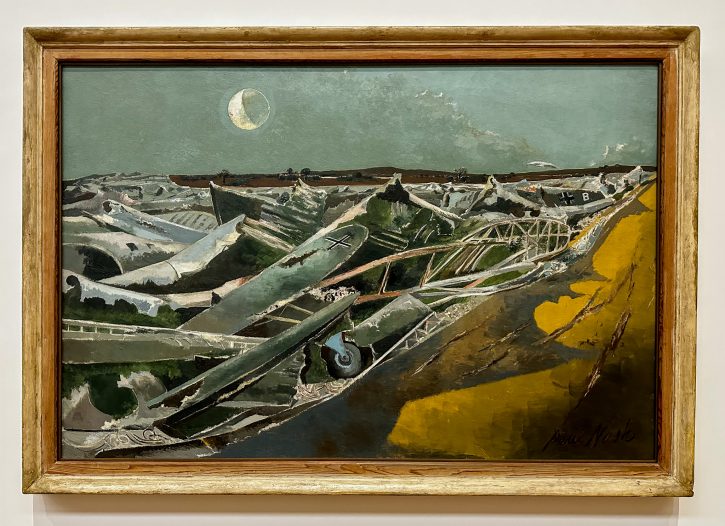Totes Meer – by Paul Nash
Seeing an original Paul Nash painting is always a revelation. His Totes Meer is a wonderful moonlit seascape of ruined German planes. His work as a War artist meant he substituted the objects of war for natural objects, but never changed his love for the landscape. This magnificent eerie work was inspired by the Morris Motors car factory in Cowley, where wrecked aircraft were stored.
Here, the metal wreckage is formed into crests of waves and their moon shadows project onto what appears to be a beach. His love of surrealism influenced this painting and I adore the sharp, menacing shadows of the waves. They remind me of the use of shadows in the work of Giorgio de Chirico.
Here’s the painting from my trip to Tate Britain:
I love the owl, painted white, flying from the right. Perhaps it’s a Barn Owl, and perhaps it’s a symbol of death. Perhaps it shows the triumph of nature, still flying, despite the death and destruction due to man. Maybe it’s not symbolic at all, and merely there as a way of showing scale and linking with the clouds.
Paul Nash was an official war artist in both the First and Second World Wars.
He was briefly a full time salaried artist for the Royal Air Force and Air Ministry, appointed by the War Artists’ Advisory Committee (WAAC). He completed a series of paintings of crashed German aircraft in English landscapes with titles like Bomber in the Corn and The Messerschmidt in Windsor Great Park. The Air Ministry representative on the WAAC committee wanted heroic portraits of pilots and aircrew and disliked Paul Nash’s modernist style so much they sacked him. The chair of the WAAC was so horrified he agreed to set aside £500 to buy paintings by Paul Nash on the theme of aerial combat, and they bought four in the next four years. Totes Meer was one of them.
Kenneth Clark said that Totes Meer was “the best war picture so far I think”. It is still one of the most celebrated British paintings of World War II.
Here’s what the label says:
Paul Nash painted this during the Second World War. It was inspired by a wrecked Luftwaffe aircraft dump at Cowley in Oxfordshire. He described the sight:
‘The thing looked to me suddenly like a great inundating sea… the breakers rearing up and crashing on the plain… nothing moves, it is not water or even ice, it is something static and dead.’
Nash, a British artist, chose to title the work in German.
